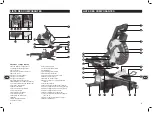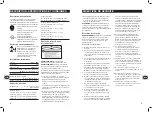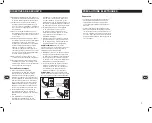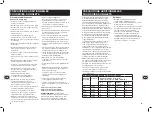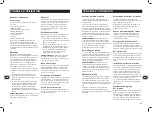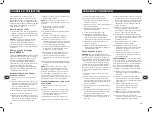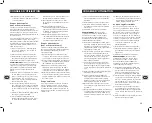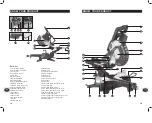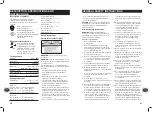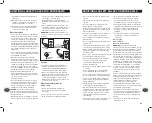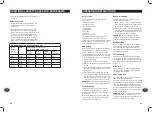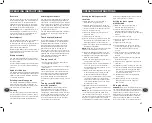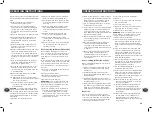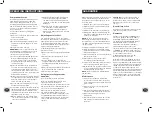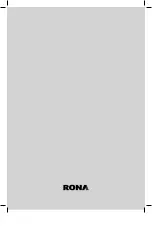
24
GB
25
GB
• Damage to hearing if effective earmuffs are
not worn.
Extension cords
• Replace damaged cords immediately. Use
of damaged cords can shock, burn or
electrocute.
• If an extension cord is necessary, a cord
with adequate size conductors should be
used to prevent excessive voltage drop, loss
of power or overheating. The table shows
the correct size to use, depending on cord
length and nameplate amperage rating of
tool. If in doubt, use the next heavier gauge.
Always use U.L. and CSA listed extension
cords.
RECOMMENDED SIZES OF EXTENSION CORDS
Tool’s
Ampere
rating
Volts
Total length of cord in feet
Cord size in A.W.G. (minimum)
25 ft
(7.6 m)
50 ft
(15.2 m)
100 ft
(30.5 m)
150 ft
(45.7 m)
3–6
120V~
18
16
16
14
6–8
120V~
18
16
14
12
8–10
120V~
18
16
14
12
10–12
120V~
16
16
14
12
12–16
120V~
14
12
-
-
ADDITIONAL SAFETY RULES FOR MITRE SAWS
OPERATING INSTRUCTIONS
Accessories
The tool is supplied with the following
accessories:
• Saw blade (fitted)
• Workpiece clamp
• Hex key 1/4” (6mm)
• Side bars x2
• Stabiliser Bar
• Dust bag
• Padlock
• Instruction manual
We recommend that you purchase your
accessories in the store from where you
obtained the tool. Use good quality accessories
and the brand recommended by the vendor.
Sales staff will help and offer advice.
Unpacking
Due to modern mass production techniques,
it is unlikely that your Rona Power Tool is
faulty or that a part is missing. If you find
anything wrong, do not operate the tool until
the parts have been replaced or the fault has
been rectified. Failure to do so could result in
serious personal injury.
1) Remove all loose parts from the carton.
2) Remove the packing materials from around
the saw.
3) Using the carrying handle (8) carefully lift the
saw from the carton and place it on a level
work surface.
4) The saw has been shipped with the saw
arm locked in the down position. To release
the saw arm, push down on the top of the
saw arm, pull on the release knob (6), rotate
it 45° and let go, slowly raise the saw arm.
WARNING.
Do not lift the saw whilst holding
on to the guards. Use the carrying handle (8).
Transportation
Lift the mitre saw only when the saw arm
is locked in the down position, the saw is
switched off and the plug is removed from the
power point.
Only lift the saw by the carrying handle (8) or
outer castings. Do not lift the saw using the
guard or operating handle (7).
Bench mounting
The saw base has holes in each corner to
facilitate bench mounting.
1) Mount the saw to a level, horizontal bench
or work table using bolts (not supplied) and
fix the saw to the bench using 4 bolts.
2) If desired, you can mount the saw to a piece
of 13mm or thicker plywood which can then
be clamped to your work support or moved
to other job sites and re-clamped.
CAUTION.
Make sure that the mounting
surface is not warped as an uneven surface
can cause binding and inaccurate sawing.
Stabiliser bar
When the saw is not fitted to a bench, always
fit the stabiliser bar (39) into the holes at the
rear of the saw base. The stabiliser helps
prevent the saw from tipping backwards when
the slide action is used.
Release knob
The release knob (6) is provided for holding
the cutting head down whilst transporting or
storing the mitre saw. The saw must never be
used with the release knob locking the head
down.
Slide lock
When tightened, the slide lock (29) prevents
the saw head from sliding. Tighten the slide
lock during transportation.
Mitre table lock
The mitre table lock (25) is used to lock the
table at the desired mitre angle.
The mitre saw cuts from 0° to 45° both left and
right. To adjust the mitre angle loosen the mitre
table lock and using the mitre table handle
adjust the mitre angle to the desired position.
The mitre table features positive click stops at
0°, 15°, 22.5°, 30° and 45° for quick setting of
common mitre angles.
WARNING.
Be sure to tighten the mitre table
lock before making a cut. Failure to do so
could result in the table moving during the cut
and cause serious personal injury.
Содержание 2001574
Страница 17: ......


